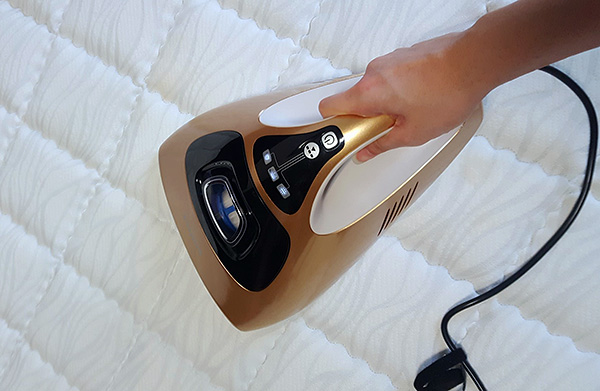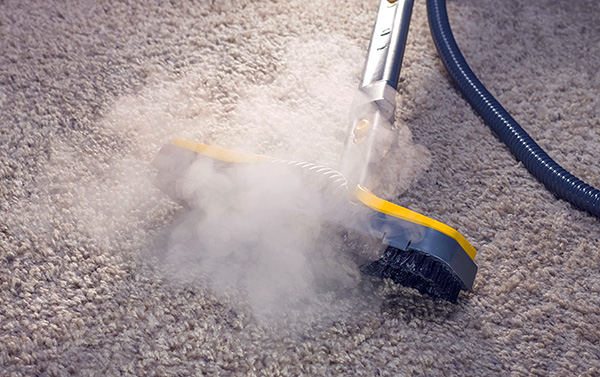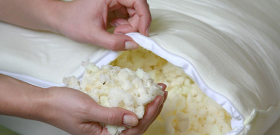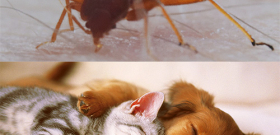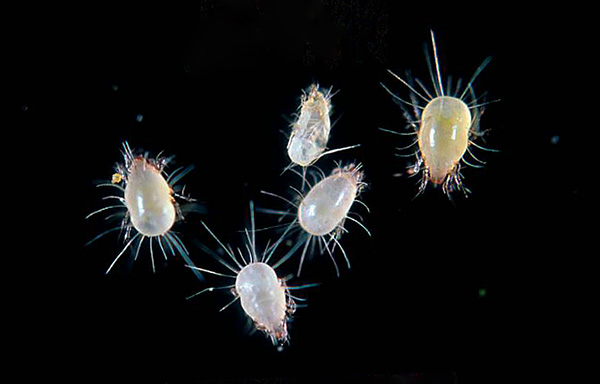
Speaking in general, several dozen species of ticks can settle in a person’s housing and constantly live - both parasitic and those that do not bite either humans or domestic animals. However, when they talk about house mites, they mean, first of all, their synanthropic species - the so-called dust mites (they are usually also called household).
These arthropods are unique in their biology - they live in most human dwellings around the planet, while they are not direct parasites of people, they do not bite them and do not suck blood. Moreover, they do not even spoil food and do not bite pets. Dust mites could be classified as a group of useful decomposers, if not for one “but”: their waste products are so harmful to human health that they very often cause severe (including chronic and deadly) respiratory diseases.
On a note
According to statistics, if at least one of the people living in a room - from an infant to an old man - has rhinitis or bronchial asthma of an unknown etiology, then with a probability of about 45%, household ticks are the cause of this disease. Most people do not even know about their presence in the room, although these pests live in close proximity to humans - in mattresses, pillows, sofas, and also just in the dust in the corners of the room.
The reason for such invisibility of dust mites is their very small size: adults reach a length of about 0.3 mm, and nymphs are even smaller. In this case, the body is translucent. It is not surprising that these arthropods not only do not catch the eye, but are also difficult to identify even with deliberate attempts to find them.
The photo below, taken using a microscope, shows a house tick in its usual habitat - in a carpet:
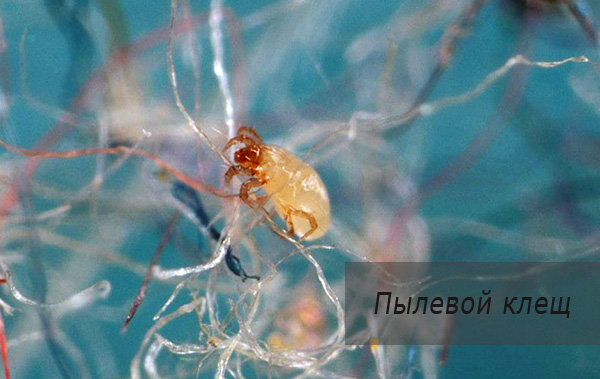
You can compare its dimensions, for example, with the thickness of a pile thread. It is quite clear that just to see the pest in the carpet will be problematic.
Nevertheless, it is not only possible, but also necessary, to assess the presence of dust mites in an apartment in order to get rid of them as soon as possible in case of severe contamination of the premises, and at the same time from the diseases that are caused by such a neighborhood. With the right approach, pests can be removed in most cases on their own.
About how to look for these unpleasant cohabitants and what to do when they are discovered, we will go on and talk in more detail ...
Features of the biology of dust mites: what they eat and where they are most often found in the apartment
House mites (they are house dust mites) are small arachnids, distant relatives of the well-known ixodid ticks (the very ones, some of whose species carry encephalitis).
Like most of their subclass relatives, dust mites are not parasites of either humans or any other animals. They feed on exfoliating particles of human skin that fall off the legs, head, arms and body, and then concentrate together with dust in corners, under skirting boards and furniture, carpets. Here, in the accumulations of apartment dust, large numbers of mites gather, diligently consuming the remnants of human skin and extracting the necessary beneficial substances from them.

It is interesting
Recent studies show that the diet of house ticks is more varied than previously thought. For example, these arthropods also actively eat mold fungi, although not all in a row - they avoid some of the mold (presumably due to the presence of toxic substances in the composition).
Dust mites have a whitish, translucent body of a rounded shape, outwardly resembling insect eggs. Their legs are in front of the body and are more suitable for holding on thin threads of carpets and in dust than for moving on flat surfaces.
Not surprisingly, house mites are generally rather sedentary creatures. You won't find them in the house, running on the floor or on the bed linen, and they don't even move much when they're in the dust. That is why few people notice them even where there are a lot of these pests. However, if you arm yourself with a magnifying glass, they resemble small whitish dots (0.2-0.3 mm in size) in dust balls or on bed frames. Most people just don't pay attention to them.
On a note
House dust mites include several types of synanthropic mites. Of these, only two species are the most numerous and widespread: the European dust mite Dermatophagoides pteronyssinus and the American dust mite Dermatophagoides farinae.
House dust can also harbor other types of mites that feed on organic debris, such as the hairy house mite Glycyphagus domesticus.They all look very similar to each other, and at home it is almost impossible to distinguish between them. But the need for such species identification does not arise in practice: the methods for detecting and destroying these creatures are the same for different species.
The following photo shows the dust mite Glycyphagus domesticus:
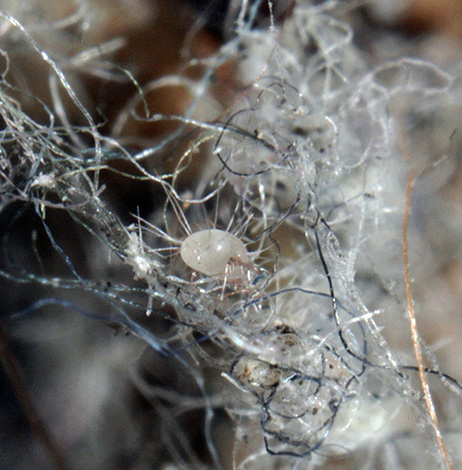
Under favorable conditions, each dust mite lives for about 2-3 months, and this period also includes the duration of the larval (nymphal) stage. Approximately 2/3 of the life cycle of the tick spends at the nymph stage, constantly growing, molting several times, and then turning into an imago - an adult arthropod capable of reproduction. At this stage, the mites mate, after which the females begin to lay 2-3 eggs every day.
Over the entire adult life, the female lays from 60 to 100 eggs, after which she dies.
This is what an adult dust mite looks like under an electron microscope:
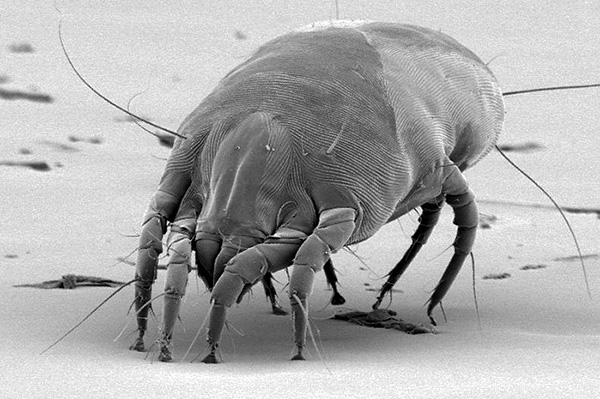
Dust mite eggs are so small that they are almost invisible to the naked eye. They also have a whitish shell, their diameter does not exceed 0.1 mm.
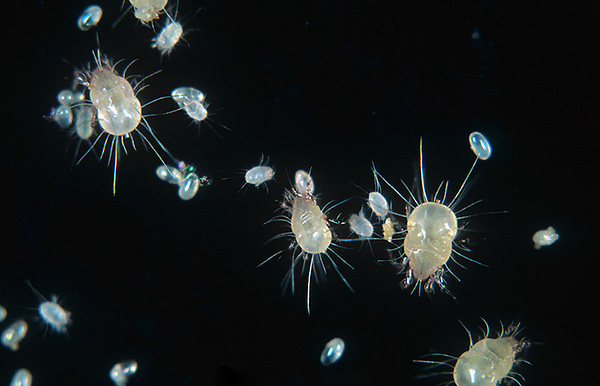
The excrement of dust mites is even less noticeable, but it is they (and not the mites themselves) that are most dangerous to humans, since they contain proteins that cause allergic sensitization ...
Human danger
Domestic ticks do not bite humans. Evolutionarily, they have not formed a need for this, and therefore, in itself, neither a person nor any of his pets are interested in ticks.
On a note
Therefore, if bites constantly appear on the body of residents in an apartment, then you should not suspect dust mites in them. The culprits here are most likely mosquitoes, bedbugs, fleas, linen lice, or, less likely, pigeon mites (we will talk about them a little later).
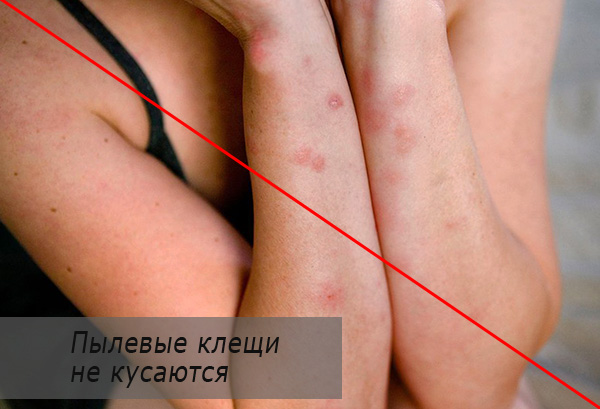
House ticks are dangerous because they can cause severe allergic reactions. The main mite allergens are digestive enzymes that facilitate the digestion of skin particles in the digestive tract. Some of the enzymes are excreted with excrement, and when these waste products dry up and are destroyed, they enter the air, are inhaled by a person and settle on his skin. Due to their high biochemical activity, they act in a complex way: they irritate the skin itself and the mucous membranes of the respiratory tract, and also stimulate the immune response, causing allergies.
On a note
The diameter of the excrement of household ticks is about 30 microns (0.03 mm). Due to their small size, they can easily be picked up by air when children play, sweep the floor, and then inhaled by a person.
Often the consequences of regular contact with the excrement of dust mites are the following diseases:
- Chronic rhinitis (sometimes with allergy symptoms, sometimes without them), accompanied by persistent nasal congestion;
- Rhinoconjunctivitis with characteristic allergy symptoms;
- Atopic dermatitis;
- Bronchial asthma.
On a note
Some experts even believe that more than half of the cases of bronchial asthma in the world are associated with an allergy to the discharge of domestic ticks.

Pain in the eyes, watery eyes, and nasal congestion that worsens at home are one of the signs of dust mites.
Also strong allergens are particles of chitinous shells of nymphs shed during molting. Similarly, allergies can arise or intensify in response to contact with the integument of dead mites - there are also many of them in the dust.
A characteristic feature of all diseases caused by tick-borne allergens is the difficulty of elucidating their etiology. Without special allergy tests, it is almost impossible to find out that rhinitis or asthma developed precisely after a reaction to tick excrement. And many people do not attach much importance to nasal congestion, they often try to find out the cause of persistent dermatitis on their own and, of course, cannot do this.
There is a certain danger in this: complex and not always harmless means and methods, up to and including surgical intervention, are often mistakenly used to treat such diseases. While the true cause of the development of pathology can be literally at hand - for example, in a mattress and pillow.
Reasons for the appearance of house ticks and optimal conditions for their life indoors
The optimal conditions for the life of dust mites coincide with the typical microclimate of a city apartment or house. They are well suited for temperatures in the range of 18-25 ° C and relative humidity of 50-85%. They can survive at slightly lower and slightly higher temperatures, but development in these cases is slowed down. Their activity also decreases at low humidity, but does not completely stop - if a person can live in the room, then ticks will survive here.
On a note
In winter, in most Russian apartments, due to the operation of heating devices, very low air humidity (below 20%) is maintained. However, if no efforts are made, the population of house ticks does not completely die from this. Individuals continue to breed, albeit not at the same rate as in other seasons.
In the largest numbers, mites are found in places of accumulation of dust and exfoliating human skin. As a rule, these are the joints of skirting boards with floors, corners of rooms in which the floor is rarely washed, spaces under furniture, junctions of parts of bed and sofa bodies, spaces in sofas (therefore, pests are sometimes called sofa mites).
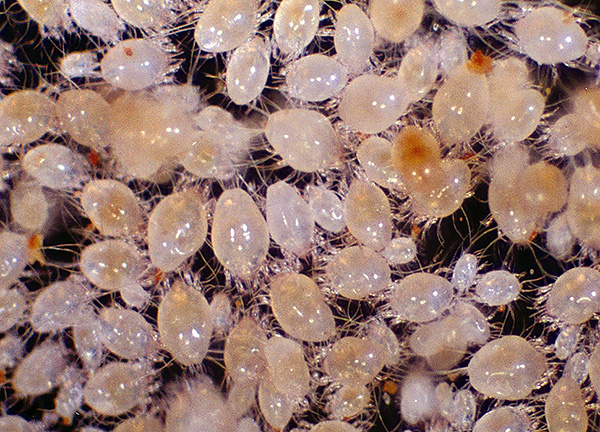
Dust mites can also be found in other places where there is not much dust itself. For example, they are often found on beds, under mattresses, in sofa cushions and blankets, even in flower pots. They can also settle in large numbers in carpets, in which the exfoliating epidermis of a person accumulates in abundance.
Ticks usually get into the room itself with furniture, as well as on various items that people bring here. Including, they can be brought in bags and suitcases with clothes, on shoes with dust. Independently between apartments and houses, they practically do not settle due to their inability to move over considerable distances. That is, in most cases, they are brought into the house by the people themselves, who then wonder where these pests come from.
How to understand that it is dust mites
When trying to detect dust mites in an apartment, you need to be able to correctly identify and distinguish them from some other arthropods that can be found here.
Perhaps the easiest way to confuse them with spider mites, often settling on houseplants. The latter have similar dimensions (0.3-0.5 mm) and, when viewed with the naked eye, look like the same bright dots as their “dusty relatives”.
These species can be distinguished primarily by their meeting places in the house: spider mites accumulate precisely on the leaves and stems of plants whose juice they feed on. They also braid the plant with a thin, but clearly visible cobweb. House dust mites do not occur on plants and do not form cobwebs.
For example, the photo below shows a cluster of dust mites when zoomed in:
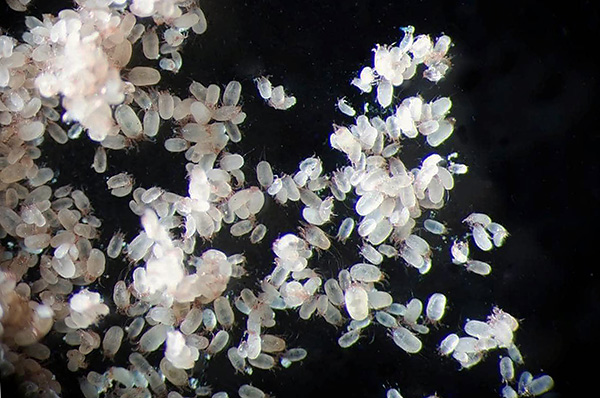
And here are spider mites on a houseplant:

It is easiest to distinguish ticks from any insects if you look at them with a magnifying glass or with a school microscope and count the number of legs. Ticks have 8 of them, they are quite clearly visible when magnified. Any insects and their nymphs (for example, nymphs of bed bugs or linen lice) have only 6 paws.
In addition, it is worth remembering that the vast majority of insects living in human housing are much larger than dust mites. Even the smallest nymphs of bedbugs and cockroaches range in size from 0.5 mm to several millimeters, are clearly visible without any magnifying equipment and run quite fast.
This is how, for example, the nymphs of bed bugs look like (eggs are also visible):

Therefore, if some kind of arthropod was noticed in the room, then most likely it is not a house tick - the latter can be seen only if you look very closely at a ball of dust with an accumulation of these pests.
It is also useful to keep in mind that, in addition to dust mites, some other representatives of this subclass can also settle in the room, which, although they cannot be called truly domestic (because they live in houses much less frequently than in other rooms), but which may not become man's sweetest neighbors...
A few words about the pigeon tick and some other pests that can be found in homes
Perhaps the most unpleasant mites that can constantly live in a human home are bird mites. There are several dozen species of them, some of which are permanent parasites of birds and live in their feathers or on the skin, and some settle near bird nests and simply visit their owners to feed on blood. It is the latter that can settle in human housing.
Often in apartments (especially those located on the top floors of houses, under attics) and in private houses, the so-called red chicken mite is found. It is also sometimes referred to as the pigeon mite.

Its main habitats are chicken coops, attics with pigeon settlements, sheds, outbuildings, and in the wild - colonies of birds (for example, swallows or rooks), from where it moves closer to humans. Living in attics, it can penetrate into apartments through cracked walls, ventilation and engineering communications, settling here in warmth and comfort. During the non-breeding season, when there are very few birds in attics, these parasites can actively bite people and domestic animals.
The photo shows a cluster of red chicken mites on a bird:

The bites of these arachnids are painful and leave itchy blisters in their place. The same bites can provoke the development of an allergic reaction.
In addition to pigeon mites, so-called barn mites can also settle in human housing - a group of species whose representatives damage various food products. For example, flour mites can harm cereals, flour, and other groceries.
The cheese mite infects long-term stored hard cheese, and the onion mite damages the bulbs of various plants. Finally, even a wine mite is known, which settles on the surface of fermented wine raw materials.
For example, the photograph below shows a head of cheese damaged by a cheese mite:

All these types of ticks rarely appear in homes. Their main habitats are various enterprises and warehouses that store large stocks of relevant products. However, you can find such neighbors in an ordinary apartment if you accidentally buy a product infected by them.
How to deal with house ticks
The fight against house (dust) mites in general is not very difficult and can be carried out independently, although there are certain nuances in it.
Firstly, due to the very small size of ticks, it is not so easy to find them in order to identify the places of greatest concentrations. For this reason, often people do not even suspect that their health problems are associated with dust mites and they need to be destroyed. Trying to treat chronic rhinitis, they usually buy a humidifier and a huge amount of drugs, but they don’t know about the main cause of the disease.
The first thing to do in the fight against ticks is to identify the places of their greatest concentration in the room. This can be done using special test systems. They are not always sold in pharmacies, but today they are easy to buy in various online stores. For example, Ventia and IAQ test systems are popular.
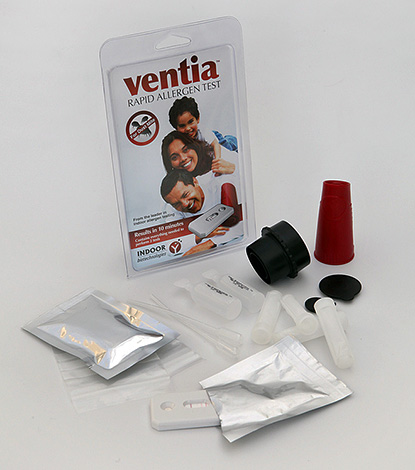
The essence of the test is simple: a little dust is taken in the test place of the room, poured into a special solution, then a test strip is lowered into the mixture.The reagent on the surface of the strip reacts to mite allergens and turns a certain color when they are present in the dust. By comparing the color of the strip with the samples indicated on a special test scale, it is possible to find out the amount of mite allergens at the place of dust sampling.
On a note
There are test systems for sensitivity to tick allergens suitable for use at home. Such a test allows a person, for example, a patient with asthma or rhinitis, to find out if he is allergic to dust mites. If the result is positive, then with a certain probability it can be assumed that the disease was provoked by ticks, and they need to be searched for and destroyed in the house.
Secondly, it is important to understand that if dust mites have settled in the house, large numbers of them can be behind baseboards, in parquet crevices, inside mattresses, that is, where they can neither be seen nor reached. Therefore, checking the premises with the help of a test system gives a result with a large error - where there are the most ticks, it is sometimes impossible to check their presence at all.
If it is determined that ticks are present in large numbers in the room, measures must be taken to remove them. Several methods can be used for this:
- Mechanical - ticks are simply removed along with dust. To do this, you can use both ordinary household vacuum cleaners and a damp cloth, and special vacuum cleaners to remove dust mites such as Philips FC6230/02 Mite Cleaner. The first option is cheaper, the second is more efficient;

- Thermal - pillows, mattresses, blankets, which can presumably be infected with ticks, are washed at the maximum allowable temperature.They can also be warmed up by leaving them in a closed car in the sun in summer - the temperature here rises to a level at which all ticks die. Finally, both these things and furniture can be treated with hot steam from a steam generator;

- Chemical, in which the room is treated with special acaricides or universal pesticides that combine acaricidal and insecticidal activity. These can be both ordinary household preparations, for example, the Raid, Raptor lines, as well as available Karbofos in ampoules, Sinuzan and others, as well as more expensive products prepared on the basis of emulsion concentrates (Executioner, Get, Lambda Zone, Delcid, etc.) . By and large, even flea drops for cats and dogs can be treated, for example, with a carpet, although this would be irrational - such drugs are quite expensive. Dust mites are sensitive to most insecticidal (not necessarily acaricidal) agents, so treatment with any of them according to the instructions in most cases will provide the desired result.

Unlike the fight against various synanthropic insects, especially parasitic ones, the extermination of domestic ticks is facilitated by the fact that it does not have to be complete.
If, for example, bed bugs need to be destroyed to the last individual in order to be sure that there will be no more bites, then it is enough to fight dust mites until their mass accumulations are eliminated. Moreover, this can sometimes be done even by simple mechanical means - a vacuum cleaner and a wet rag. It is not necessary to try to completely eradicate them.Even if some of the pests remain behind the baseboards, inside the sofas, under the cabinets, the number of allergens in the room will still significantly decrease, which will greatly alleviate the patient's condition.
If in the future a thorough wet cleaning is regularly carried out in the apartment, then the number of ticks will constantly decrease further, since the main source of food for them will be removed during such cleanings.
It is interesting
It is also believed that ticks can be destroyed with the help of quartz lamps - the same ones that are used to disinfect a particular room.

Methods for combating household ticks can be combined, or you can use only one method, counting not on a quick result, but on the gradual destruction of most individuals in the population.
For example, you can wipe out all the carpets in the room, treat carpets and baseboards with any insecticidal spray (including modern versions of Dichlorvos), and sofas and mattresses with a steam generator. Then carry out wet cleaning in the apartment and sleep peacefully. If in the future, at least once a week, thoroughly wash the floors in the apartment and wipe the dust everywhere, this will be a reliable prevention of the mass reproduction of ticks.
Heavily infected furniture, especially upholstered furniture, should either be frozen outside in winter, or treated with hot steam from a steam generator, or treated with any insecticidal spray. This will be a sufficient guarantee that the mites that may have settled under the upholstery will die.
It is also useful to use sprays such as Easy Air for spraying particularly infested areas. They contain biodegradants, which lead to the destruction of tick-borne allergens and reduce the severity of people's reactions to them.

Finally, you can quickly and completely get rid of ticks by ordering professional treatment (it is sometimes incorrectly called disinfection). This will save the owner of the premises from the need to handle the apartment on their own and, with a high probability, will immediately give a positive result. In some institutions (for example, in kindergartens and schools), only specially trained exterminators can poison any pests.
Protecting housing from these arthropods
Due to their small size and almost invisible to humans, dust mites can be very easily brought into the room. However, with the observance of preventive measures, you should not be afraid of this. Although it is believed that most apartments and houses are infected with these arachnids, only in some rooms they multiply in such quantities that they become a threat to human health.

Simply put, it is unlikely that you will be able to completely and permanently protect your home from the presence of dust mites in it. But it is possible to protect housing from the mass reproduction of these arthropods, which will help to reliably protect against diseases provoked by them.
The most effective preventive measures include:
- Regular wet cleaning. If it is carried out at least once a week, then this will be enough to prevent excessive reproduction of ticks, since during cleaning both the individuals themselves and their eggs and food sources are washed off - particles of human skin;
- Removal of unnecessary "dust collectors" - carpets, rugs, carpet paths, excess soft toys;
- Regular cleaning of air conditioner filters and trash bag in a vacuum cleaner.
At the same time, one should not be afraid that the number of dust mites in the room will increase while maintaining normal humidity in it (for example, when a humidifier is running). In fact, the above preventive measures will ensure reliable regulation of the number of ticks, and even the optimal humidity for them will not allow them to multiply massively in a clean, well-groomed apartment.
Useful video: what causes the presence of dust mites in bed

